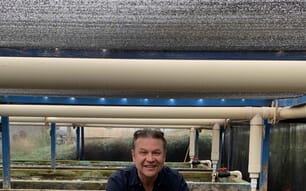Producing fish, such as salmon, on land in recirculating systems has its benefits. It allows the farmer more control over the quality and condition of the water, better health management and uses less water.
It is also less harmful to the environment as waste is disposed of in a more controlled way or is transferred back into the system.
According to the experiences of Justin Henry, Target Marine, speaking at the Aqua Nor 2015 conference, successful RAS production should optimise:
- health - it is very important that you keep disease out by double checking that the eggs and water you bring into the system is disease free.
- density - keep your tanks full to increase efficiency
- water use and quality - it is important that your water provides exactly what the fish need
- photoperiod
- production value and product quality
Mr Henry also noted that careful thought needs to be taken when deciding what fish to farm in a recirculating system.
It is important that you follow a criteria for selecting fish for your recirculating system if you want the system to work and be profitable, explained Mr Henry.
Firstly, choose only fish that have an existing demand. You also want a fish that can be produced year round in response to market demand and, preferebly, a fish with high market value and a short production cycle is beneficial.
Fish used in RAS should also have a moderate temperature preference, be tolerant to some stress and have the potential for genetic improvement.
Mr Henry explained that his experience in Canada with farming Atlantic salmon in RAS has so far been successful and that salmon is well suited to this farming method.
With the farming of salmon in RAS in mind, Frode Mathisen, Grieg Seafood, addressed whether or not today's ocean farmed salmon could be moved into land based recirculating systems.
Mr Mathisen explained that his experience with RAS, is that so far it is working very well as it has high production rates and is competitive.
However, RAS has also had some system issues and the financing of setting up RAS farm remains expensive and difficult in many places.
Yet, Mr Mathisen believes that, in time, RAS will be more of a success as issues are solved and costs go down.
Despite the advantages and success stories of RAS, Mr Mathisen stated that it would not be viable to move salmon production from the sea to the land.
Huge amounts of salmon are produced in the ocean and to move just Norway's ocean salmon farming on land alone would cost NOK 222 billion, said Mr Mathisen.
Clearly, this is not cost effective. There would also be issues with space and where the farms could be located. Norway is also an expensive country - it would be 30 per cent cheaper to build RAS in the UK rather than Norway.
It is not realistic to close all of today's open production, reiterated Mr Mathisen. However, much more of salmon's early smolt production can be done on land, with Mr Mathisen expecting growth from the current two per cent to 20 per cent.
Instead of replacing open sea salmon culture, RAS should supplement it, Mr Mathisen said.
However, Yoav Dagan, Aqua Moaf, Isreal, is a true believer in RAS and explained why he moved his fish farming operations to land based production.
Isreal's open waters are not ideal for the year round farming of tropical or cold water fish due to the seasonal changes in water temperature said Mr Dagan.
There have also been big problems with disease and as a result, Mr Dagan moved his operations onto land where he could have more control over health management and water parameters.
Mr Dagan's indoor RAS has zero discharge, low maintainence, stable water quality, low energy costs and a cost of production at around $2.77 a kilo.
With no mechanical or chemical elements, the system stabilises itself and has proved to be a much more efficient way of producing fish than it was farming in the ocean.
However, Mr Dagan did agree that RAS should be complimentary to open sea production and should not replace it.




